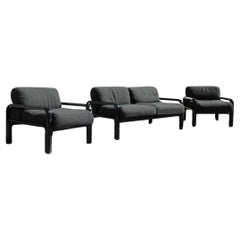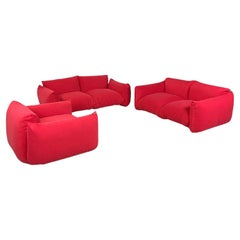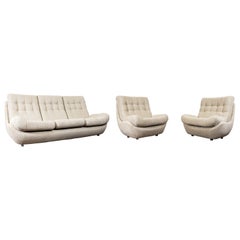Polystyrene Living Room Sets
1
1
to
1
1
2
1
1
1
1
1
1
1
Height
to
Width
to
Depth
to
1
1
2
1
1
1
1
1
1
1
1
1
425
1,813
1,708
776
644
1
1
1
1
1
1
Material: Polystyrene
Eastern Bloc Vintage living room set by Jitona, Czechoslovakia, 1970s
By Jitona
Located in Prague 8, CZ
This set was a part of a living room set made by JITONA company in the 1970´s. It´s consist of two armchairs and one pouffe. You can also simply turn it into a bed.
It represent a ty...
Category
Late 20th Century Czech Mid-Century Modern Polystyrene Living Room Sets
Materials
Fabric, Foam, Polystyrene
Titi 01 Table and Stool by Mary-Lynn & Carlo
Located in Geneve, CH
TITI 01 table and stool by Mary-Lynn & Carlo, 2021.
The Elephant Project.
Dimensions: stool H 42 x W 42 x D 42 cm.
Table H 45 x W 98 x D 35 cm.
Materials: concrete colored, foam...
Category
2010s Lebanese Modern Polystyrene Living Room Sets
Materials
Concrete
Related Items
Living Room Sets Gae Aulenti for Knoll 1970s Black Grey Italian Style
By Gae Aulenti
Located in Palermo, Sicily
Living Room Sets Gae Aulenti for Knoll 1970s Black Grey
Category
1970s Italian Mid-Century Modern Vintage Polystyrene Living Room Sets
Materials
Metal
H 29.53 in W 61.03 in D 37.41 in
Italian modern red living room Marenco by Mario Marenco for Arflex, 1970s
By Mario Marenco, Arflex
Located in MIlano, IT
Italian modern red living room Marenco by Mario Marenco for Arflex, 1970s
Living room composed of two two-seater sofas and an armchair mod. Ma...
Category
1970s Italian Modern Vintage Polystyrene Living Room Sets
Materials
Metal
H 23.63 in W 66.93 in D 39.38 in
Pair of Venetian Armchairs and Stool
Located in Leamington Spa, Warwickshire
Pair of 19th C Venetian hand-painted armchairs and stool with traces of the original paint showing through. 1880.
Stool dimensions: 20.5"W x 15"D x 17.5"H
Chair dimensions are be...
Category
19th Century Italian Antique Polystyrene Living Room Sets
Materials
Wood
The Sayari Indoor/Outdoor Daybed Chaise and Table Set by Studio Lloyd - In Stock
Located in New York, NY
The luxurious Sayari Outdoor Collection is inspired by the beauty of the African continent. The return of sculptural and curved seating - outdoors. Instead of using traditional shape...
Category
21st Century and Contemporary South African Modern Polystyrene Living Room Sets
Materials
Wood
H 24.4 in W 47.2 in D 94.5 in
Carlo Scarpa Iroko Wood and Green Velvet Cornaro Sofa for Studio Simon, 1974
Located in Vicenza, IT
Cornaro two-seater sofa, designed by Carlo Scarpa and manufactured by Studio Simon in 1974.
Made of Iroko wood, foam, and azure chenille velvet.
Excellent vintage condition.
Born in Venice on June 2nd, 1906, Carlo Scarpa began working very early. Only a year after he had first qualified as an architect in 1926, he began working for the Murano glassmakers Cappellin & Co. in a consultative capacity; from 1927, he began to experiment with the Murano glass, and this research not only gave him excellent results here but would also inform his progress for many years to come. Between 1935 and 1937, as he entered his thirties, Carlo Scarpa accepted his first important commission, the renovation of Venice’s Cà Foscari. He adapted the spaces of this stately University building which stands on the banks of the Grand Canal, creating rooms for the Dean’s offices and a new hall for academic ceremonies; Mario Sironi and Mario De Luigi were charged with doing the restoration work on the frescos. After 1945, Carlo Scarpa was constantly busy with new commissions, including various furnishings and designs for the renovation of Venice’s Hotel Bauer and designing a tall building in Padua and a residential area in Feltre, all worth mentioning. One of his key works, despite its relatively modest diminished proportions, was the first of many works which were to follow in the nineteen fifties: the [bookshop known as the] Padiglione del Libro, which stands in Venice’s Giardini di Castello and shows clearly Scarpa’s passion for the works of Frank Lloyd Wright. In the years which were to follow, after he had met the American architect, Scarpa repeated similar experiments on other occasions, as can be seen, in particular, in the sketches he drew up in 1953 for villa Zoppas in Conegliano, which show some of his most promising work. However, this work unfortunately never came to fruition. Carlo Scarpa later created three museum layouts to prove pivotal in how twentieth-century museums were set up from then on. Between 1955 and 1957, he completed extension work on Treviso’s Gipsoteca Canoviana [the museum that houses Canova’s sculptures] in Possagno, taking a similar experimental approach to the one he used for the Venezuelan Pavilion at [Venice’s] Giardini di Castello which he was building at the same time (1954-56). In Possagno Carlo Scarpa was to create one of his most incredible ever works, which inevitably bears comparison with two other museum layouts that he was working on over the same period, those of the Galleria Nazionale di Sicilia, housed in the Palazzo Abatellis in Palermo (1953-55) and at the Castelvecchio in Verona (1957- 1974), all of which were highly acclaimed, adding to his growing fame. Two other buildings, which are beautifully arranged in spatial terms, can be added to this long list of key works that were started and, in some cases, even completed during the nineteen fifties. After winning the Olivetti Award for architecture in 1956, Scarpa began work in Venice’s Piazza San Marco on an area destined to house products made by the Industrial manufacturers Ivrea. Over the same period (1959-1963), he also worked on renovating and restoring the gardens and ground floor of the Fondazione Querini Stampalia in Venice, which many consider one of his greatest works. While he worked on-site at the Fondazione Querini Stampalia, Carlo Scarpa also began building a villa in Udine for the Veritti family. To shed some light on how much his work evolved over the years, it may be useful to compare this work with that of his very last building, villa Ottolenghi Bardolino, which was near completion at the time of his sudden death in 1978. Upon completion of villa Veritti over the next ten years, without ever letting up on his work on renovation and layouts, Scarpa accepted some highly challenging commissions which were to make the most of his formal skills, working on the Carlo Felice Theatre in Genoa as well as another theatre in Vicenza.
Towards the end of this decade, in 1969, Rina Brion commissioned Carlo Scarpa to build the Brion Mausoleum in San Vito d’Altivole (Treviso), a piece he continued to work on right up until the moment of his death. Nevertheless, even though he was totally absorbed by work on this mausoleum, plenty of other episodes can offer some insight into the final years of his career. As work on the San Vito d’Altivole Mausoleum began to lessen in 1973, Carlo Scarpa started building the new headquarters for the Banca Popolare di Verona. He drew up plans that were surprisingly different from the work he carried out simultaneously on the villa Ottolenghi. However, the plans Carlo Scarpa drew up, at different times, for a monument in Brescia’s Piazza della Loggia commemorating victims of the terrorist attack on May 28th, 1974, make a sharp contrast to the work he carried out in Verona, almost as if there is a certain hesitation after so many mannered excesses. The same Pietas that informs his designs for the Piazza Della Loggia can also be seen in the presence of the water that flows through the Brion Mausoleum, almost as if to give a concrete manifestation of pity in this twentieth-century work of art. Carlo Scarpa has put together a highly sophisticated collection of structures occupying the mausoleum’s L-shaped space stretching across both sides of the old San Vito d’Altivole cemetery. A myriad of different forms and an equally large number of different pieces, all of which are separate and yet inextricably linked to form a chain that seems to offer no promise of continuity, arising out of these are those whose only justification for being there is to bear the warning “si vis vitam, para mortem,” [if you wish to experience life prepare for death] as if to tell a tale that suggests the circle of time, joining together the commemoration of the dead with a celebration of life. At the entrance of the Brion Mausoleum stand the “propylaea,” followed by a cloister that ends by a small chapel, with an arcosolium bearing the family sarcophagi, the central pavilion, held in place on broken cast iron supports, stands over a mirror-shaped stretch of water and occupies one end of the family’s burial space. The musical sound of the walkways, teamed with the luminosity of these harmoniously blended spaces, shows how, in keeping with his strong sense of vision, Carlo Scarpa could make the most of all his many skills to come up with this truly magnificent space. As well as an outstanding commitment to architectural work, with the many projects we have already seen punctuating his career, Carlo Scarpa also made many equally important forays into the world of applied arts. Between 1926 and 1931, he worked for the Murano glassmakers Cappellin, later taking what he had learned with him when he went to work for the glassmakers Venini from 1933 until the 1950s. The story of how he came to work on furniture design is different, however, and began with the furniture he designed to replace lost furnishings during his renovation of Cà Foscari. The later mass-produced furniture started differently, given that many pieces were originally one-off designs “made to measure.” Industrial manufacturing using these designs as prototypes came into being thanks to the continuity afforded him by Dino Gavina, who, as well as this, also invited Carlo Scarpa to become president of the company Gavina SpA, later to become SIMON, a company Gavina founded eight years on, in partnership with Maria Simoncini (whose own name accounts for the choice of company name). Carlo Scarpa and Gavina forged a strong bond in 1968 as they began to put various models of his into production for Simon, such as the “Doge” table, which also formed the basis for the “Sarpi” and “Florian” tables. In the early seventies, other tables that followed included “Valmarana,” “Quatour,” and “Orseolo.” While in 1974, they added a couch and armchair, “Cornaro,” to the collection and the “Toledo” bed...
Category
1970s Italian Mid-Century Modern Vintage Polystyrene Living Room Sets
Materials
Velvet, Foam, Chenille, Wood
H 25.6 in W 86.62 in D 34.26 in
1950s Dining Room Set by Jitona, Czechoslovakia
By Jitona
Located in Praha, CZ
- good original condition with minor signs of use
- Chairs have been newly upholstered
- Table in oak finish
- Chairs made of stained beech wood
- Chairs dimensions : Height 86cm, S...
Category
1950s Czech Mid-Century Modern Vintage Polystyrene Living Room Sets
Materials
Fabric, Wood, Beech
Living Room Set for Kids
Located in Brooklyn, NY
Sweet rattan chairs and matching table form the 1950s.
Category
1950s French Mid-Century Modern Vintage Polystyrene Living Room Sets
Materials
Rattan
1970s Living Room Beech Set, Czechoslovakia
Located in Praha, CZ
- good original condition with minor signs of use
- Dimensions of the Sofa: 86x197x82.
Category
1970s Czech Mid-Century Modern Vintage Polystyrene Living Room Sets
Materials
Wood, Beech
Airisto Side Table and Stool
Located in Halikko, Finland
Airisto side table with Joanna Laajisto.
The Airisto collection's furnishings are multifunctional – they can be used as a side table, stool and a b...
Category
21st Century and Contemporary Finnish Scandinavian Modern Polystyrene Living Room Sets
Materials
Ash
The Sayari Indoor / Outdoor Daybed Chaise and Table Collection by Studio Lloyd
Located in New York, NY
The luxurious Sayari Outdoor Collection is inspired by the beauty of the African continent. The return of sculptural and curved seating - outdoors. I...
Category
21st Century and Contemporary South African Modern Polystyrene Living Room Sets
Materials
Marble
H 24.4 in W 47.2 in D 94.5 in
Contemporary Travertine Stool or Side Table, Arch 01.2 C by Barh Design
Located in Antwerp, Antwerp
arch 01.2 c is a stool or side table. The arch 01.2 c takes things a little bit further than its precedent, the arch 01.1 c. It was designed into our latest travertine collection. A ...
Category
21st Century and Contemporary Belgian Other Polystyrene Living Room Sets
Materials
Stone, Travertine, Marble
H 17.72 in W 13.39 in D 13.39 in
Very Rare Set of Two Lounge Chairs and Stool by Cassina
By Cassina
Located in Munich, DE
Foam and wonderful fabric in good condition. Very rare low back version - used by gio ponti for the famous hotel parco dei principi in sorrento. Made by Cassina.
Category
1950s Italian Mid-Century Modern Vintage Polystyrene Living Room Sets
Materials
Fabric
Previously Available Items
Space Age Living Room Set Atlantis in Beige Boucle, 1970's
Located in Wroclaw, PL
Space age living room set atlantis in beige boucle 1970's, Czechoslovakia.
Completely restored.
Dimensions:
sofa: W 210 x H 93 x D 96 cm.
armchairs: W 98 x H 93 x D 96 cm
Atla...
Category
Mid-20th Century Space Age Polystyrene Living Room Sets
Materials
Fabric, Polystyrene
Recently Viewed
View AllMore Ways To Browse
3 Piece Suite Modern
Artu Moss
Poiat Outdoor
Cub Chair
Siete Studio
Swedish Animal Skin Living Room Sets
1930s Animal Skin Living Room Sets
Antique Parlour Set
Aubusson Salon Set
Split Reed Bamboo Sofa
North American Velvet Living Room Sets
German Hardwood Living Room Sets
Rossi D Albizzate
Beige Scandinavian Modern Living Room Sets
Dutch Hardwood Living Room Sets
Early 1900s Bentwood Living Room Sets
Niels Christensen
North American Mahogany Living Room Sets




